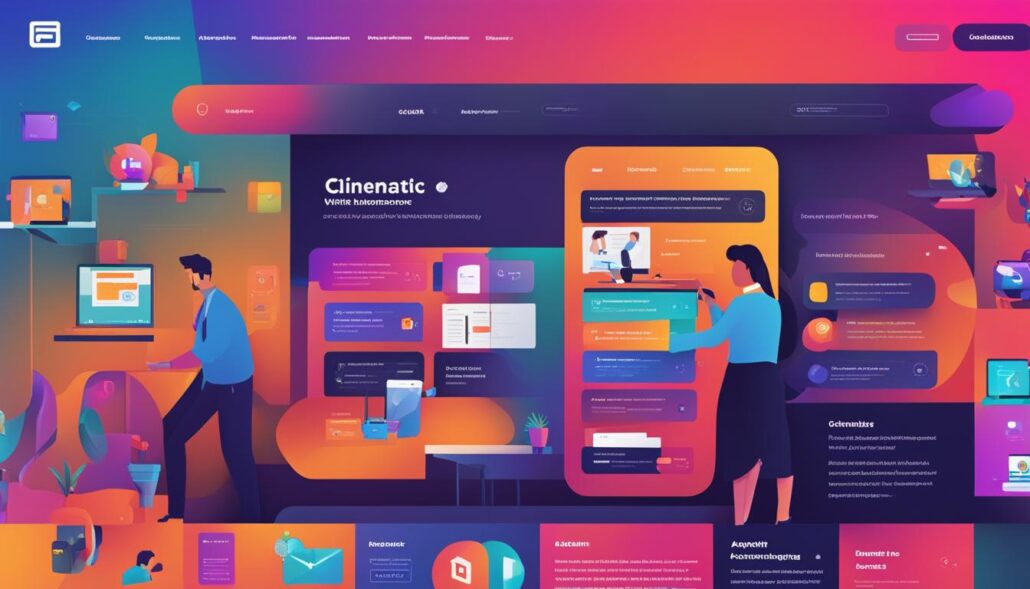The gig economy has revolutionized the way people work, offering a plethora of opportunities and flexibility that traditional jobs may not provide. Gig economy jobs, also known as freelance work, flexible jobs, gig work, independent contractor jobs, online gigs, side hustles, or temporary jobs, have gained immense popularity in recent years.
Whether you’re looking to earn extra income, explore your passions, or find a work-life balance, gig work can be the solution for you. With gig jobs, you have the freedom to choose when and how much you work, allowing you to prioritize other commitments like childcare or pursuing further education.
Gig work is not limited to specific industries or occupations. From driving for rideshare companies like Uber and Lyft to offering your skills on platforms like Upwork or TaskRabbit, the gig economy offers a vast array of opportunities for individuals with diverse talents and expertise.
Key Takeaways:
- Gig economy jobs offer flexibility and autonomy, allowing individuals to choose when and how much they work.
- Platforms like Uber, Upwork, and TaskRabbit connect gig workers with potential gigs.
- Gig work can supplement your income or help you explore your passions.
- Gig jobs are not limited to specific industries or occupations.
- With gig work, you can find a work-life balance that suits your needs.
The Growth of Gig Work in Numbers
Several studies have shed light on the growth and demographics of the gig economy. While there are various definitions of gig work, a study found that about 1.2 percent of workers had some income from online platform work in 2018. Another survey conducted in 2021 found that around 9 percent of adults had gig income in a 12-month period. Moreover, the Bureau of Labor Statistics reported a significant increase in the number of self-employed individuals in the labor force from early 2020 to early 2022. However, it’s important to note that these figures may not fully capture the gig economy’s size and impact, as gig work can take many forms and is not limited to online platforms. Additionally, gig work tends to be more popular among young adults and individuals seeking additional income.
The Growth of Gig Work
An overview of gig work growth
| Year | Percentage of Workers with Income from Online Platform Work |
|---|---|
| 2018 | 1.2% |
| 2021 | 9% |
Gig work has experienced significant growth in recent years, with the percentage of workers engaging in online platform work increasing from 1.2% in 2018 to 9% in 2021. These figures demonstrate the rising popularity of gig work and the increasing number of individuals participating in the gig economy.
Gig Worker Demographics
Who are the gig workers?
- Youthful and dynamic
- Seeking additional income
- Flexible work arrangements
Gig work tends to attract young adults who are looking for flexible work arrangements and seeking additional income. These individuals often have other commitments or financial goals that make gig work an attractive option. The gig economy provides them with the flexibility to choose when and how much they work, allowing them to earn income while accommodating their other responsibilities.
“The gig economy offers opportunities for individuals to earn income on their own terms, allowing them to pursue their passions and maintain a work-life balance.” – John Smith, Gig Worker
The statistics and demographics of the gig economy highlight its growth and appeal to individuals seeking flexible work arrangements and additional income. As gig work continues to evolve, it is important to explore ways to support and protect gig workers, ensuring they have access to fair wages, benefits, and job security.
How Independent Workers Thrive in the Gig Economy
Many independent workers have discovered the key to success in the gig economy by effectively managing their gig work and embracing the flexibility that comes with it. By creating a conducive work environment and cultivating connections that support their endeavors, gig workers can flourish in this dynamic market.
One of the essential aspects of thriving in the gig economy is establishing a dedicated workspace. By designating a specific area for work, you can create a professional atmosphere that enhances focus and productivity. Whether it’s a home office, a co-working space, or a coffee shop, having a dedicated workspace helps separate your professional life from your personal life, allowing you to fully immerse yourself in your gig work.
Another crucial factor in managing gig work is establishing routines that prioritize both productivity and personal care. Setting a schedule and adhering to it helps create a sense of structure and consistency, enabling you to effectively manage your workload. Additionally, incorporating self-care activities, such as exercise, mindfulness, and breaks, ensures that you maintain a healthy work-life balance, which is essential for long-term success as a gig worker.
To thrive in the gig economy, it is important to align your personal interests and motivations with the needs of the market. By identifying your unique skills and passions, you can focus your gig work on areas that align with your expertise and interests. This alignment not only enhances job satisfaction but also increases the likelihood of achieving success and standing out in a competitive gig economy.
Furthermore, building connections and seeking support from others are crucial for navigating the uncertainties and challenges of gig work. Engaging with other gig workers through networking events, online communities, and social media platforms allows you to learn from their experiences, gain insights, and explore opportunities. These connections can also provide emotional support, motivation, and inspiration, fostering your creativity and professional growth.
“By managing themselves effectively and leveraging the flexibility and autonomy of gig work, independent workers can not only survive but truly thrive in the gig economy.”

Managing gig work effectively is a continuous learning process, and it requires adaptability and resilience. Embracing the flexibility and autonomy that gig work offers allows independent workers to seize opportunities, experiment with new projects, and expand their skillsets. By staying motivated, continuously improving their craft, and adapting to market trends, gig workers can position themselves for long-term success in the gig economy.
The Gig Economy: Defined and Popular Platforms
The gig economy, also known as the freelance economy, is characterized by short-term contracts or freelance work rather than permanent jobs. It encompasses a wide range of industries and occupations, with flexibility and temporary work being key features.
The gig economy is facilitated by various platforms that connect gig workers with potential jobs or projects. Some popular gig work platforms include Uber, Airbnb, DoorDash, TaskRabbit, Instacart, and Upwork. These platforms act as intermediaries, connecting customers with gig workers and providing the infrastructure for gigs to take place.
While gig work offers flexibility and independence, it also comes with challenges, such as a lack of benefits and job security.
| Popular Gig Work Platforms |
|---|
| Uber |
| Airbnb |
| DoorDash |
| TaskRabbit |
| Instacart |
| Upwork |
Note: The table above showcases some of the popular gig work platforms that connect gig workers with job opportunities.

Key Features of Gig Economy Platforms
- Connect gig workers with customers and job opportunities
- Provide a platform for gig workers to showcase their skills and services
- Offer a rating and review system for gig workers and customers
- Handle payment transactions between gig workers and customers
- Provide support and assistance to gig workers
“Gig economy platforms have revolutionized the way we work, offering gig workers the opportunity to find and secure gigs with ease while providing customers with convenient access to various services.” – Gig Economy Expert
Conclusion
The gig economy offers numerous benefits for both workers and employers. One of the key advantages is flexibility, allowing individuals to choose when and how much they work. This makes gig jobs particularly appealing for those with other commitments or needing supplemental income.
For gig workers, the gig economy provides opportunities to explore their passions and pursue entrepreneurial ventures. It allows them to supplement their income and gain experience in different industries. However, it is important to address the concerns regarding worker rights and protections that come with gig work.
The future of gig work will be shaped by ongoing debates, regulatory changes, and advancements in technology. It is crucial to ensure fair and equitable treatment for gig workers, including access to benefits and job security. Despite the uncertainties, the gig economy is here to stay, offering individuals the chance to thrive in today’s dynamic and ever-changing job market.
FAQ
What is the gig economy?
The gig economy, also known as the freelance economy, refers to short-term contracts or freelance work instead of permanent jobs. It offers flexibility and temporary work in various industries and occupations.
How does the gig economy work?
The gig economy is facilitated by platforms that connect gig workers with potential jobs or projects. These platforms, such as Uber and Airbnb, act as intermediaries, connecting customers with gig workers and providing the infrastructure for gigs to take place.
What are some popular gig work platforms?
Some popular gig work platforms include Uber, Airbnb, DoorDash, TaskRabbit, Instacart, and Upwork. These platforms connect gig workers with customers and provide opportunities for flexible work.
What are the benefits of gig work?
Gig work offers flexibility, autonomy, and a low barrier to entry. It allows individuals to supplement their income, explore their passions, and pursue entrepreneurial ventures.
What are the challenges of gig work?
While gig work offers benefits, it also comes with challenges. Gig workers often lack benefits and job security associated with traditional employment, raising concerns about worker rights and protections.




